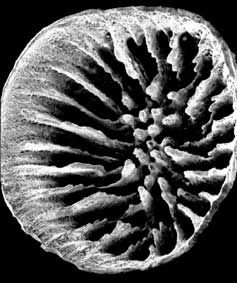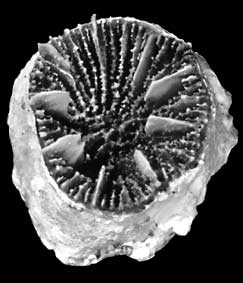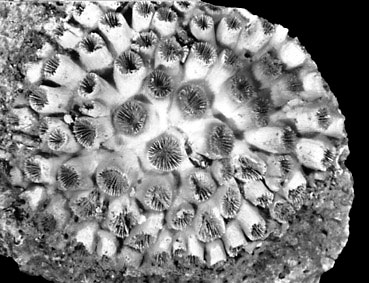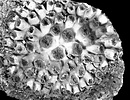Rhizangiidae
Stephen D. Cairns- Rhizangia

- Culicia
- Astrangia
- Oulangia
- Cladangia
- Arctangia

- Reussangia

- Hindeastraea

- Septastraea

- Platyhelia

Introduction
The rhizangiids are known from the Lower Cretaceous (about 135 million years ago) to the Recent, and are widespread in the tropical and temperate regions of all oceans. All species live on hard substrates on the continental shelf (0-200 m), but at least one genus (Culicia) is known from as deep as 238 m. All species are azooxanthellate; however, one (Astrangia poculata) contains populations that are also zooxanthellate (Peters et al., 1988). Among the azooxanthellate Scleractinia, the rhizangiids have most successfully occupied the neritic, hard bottom, temperate niche. All Recent rhizangiids are colonial and firmly attached, but because they rarely form large colonies, they do not contribute to shallow or deeper-water reef structure. A total of 33 Recent species is known in four genera (Cairns et al., 1999). This family is sometimes incorrectly referred to as the Astrangiidae Verrill, 1869.
Characteristics
Primarily colonial, azooxanthellate coralla formed by extratentacular budding, resulting in plocoid or reptoid colonies. Corallites usually small and low, united basally by stolons or a thin basal coenosteum. Septa composed of one fan system of simple or compound trabeculae, resulting in finely dentate septal margins. Endotheca present.



Left: Culicia hoffmeisteri : Calice of an individual corallite from a colonial skeleton collected from Victoria, Australia (depth 7 m). Diameter of corallite 5.5 mm. Photograph from Cairns and Parker, 1992. Copyright © 1995 South Australian Museum. Right: Oulangia bradleyi: Calice of an individual corallite from a colonial skeleton collected at the Galapagos (depth 14 m). Diameter of corallite 12.2 mm (from Cairns, 1991).
Discussion of Phylogenetic Relationships
No phylogenetic analysis has been performed on the genera within this family. The monophyletic nature of the family is doubtful. For instance, Chevalier (1987) included Polycyathus in this family, and Verheij and Best (1987) included both Polycyathus and Paracyathus as rhizangiids, whereas Cairns and Zibrowius (1997) considered both of these genera to be caryophylliids, as well as transferring Colangia and Phyllangia from the Rhizangiidae to the Caryophylliidae. Recent molecular analyses (Romano and Cairns, 2000) place Polycyathus and Paracyathus with the Oculinidae, but as yet no nucleic acids from rhizangiids have been sequenced.
References
Cairns, S. D. 1991. A revision of the ahermatypic Scleractinia of the Galápagos and Cocos Islands. Smithsonian Contributions to Zoology, 504: 32 pp.
Cairns, S. D. 1994. Scleractinia of the temperate North Pacific. Smithsonian Contributions to Zoology, 557: 150 pp.
Cairns, S. D. 1995. The marine fauna of New Zealand: Scleractinia (Cnidaria: Anthozoa). New Zealand Oceanographic Institute Memoirs, 103, 210 pp.
Cairns, S. D., B. W. Hoeksema, and J. van der Land. 1999. Appendix: List of Extant Stony Corals. Attol Research Bulletin, 459:13-46.
Cairns, S. D. and S. A. Parker. 1992. Review of the Recent Scleractinia (Stony Corals) of South Australia, Victoria and Tasmania. Records of the South Australian Museum, Monograph Series, 3: 82 pp.
Cairns, S. D. and H. Zibrowius. 1997. Cnidaria, Anthozoa: Azooxanthellate Scleractinia from the Philippine and Indonesian regions. Mémoires du Muséum National d'Histoire Naturelle, 172: 27-243.
Chevalier, J.-P. 1987. Ordre des Scléractiniares: Systematique. Pp. 679-753 In: Grassé (editor) Traité de Zoologie, 3(3) Masson, Paris.
Peters, E. C. et al. 1988. Nomenclature and biology of Astrangia poculata (Cnidaria: Anthozoa). Proceedings of the Biological Society of Washington, 101(2): 234-250.
Romano, S. L. and S. D. Cairns. 2000. Molecular phylogenetic hypotheses for the evolution of scleractinian corals. Bull. Mar. Sci., 67(3): 1043-1068.
Verheij, E. and M. B. Best. 1987. Notes on the genus Polycyathus Duncan, 1876 and a description of three new scleractinian corals from the Indo-Pacific. Zoologische Mededelingen, 61(12): 147-154.
Wells, J. W. 1956. Scleractinia. Pp. F328-F444 In: Moore, R. C (editor) Treatise on Invertebrate Paleontology, Part F: Coelenterata. University of Kansas Press, Lawrence.
Title Illustrations

| Scientific Name | Astrangia haimei |
|---|---|
| Location | shallow water off Monterey, California |
| Reference | Cairns, S. D. 1994. Scleractinia of the temperate North Pacific. Smithsonian Contributions to Zoology, 557: 150 pp. |
| Specimen Condition | Dead Specimen |
| Body Part | Skeleton of a symmetrically growing colony |
| Size | Colony 50 mm in diameter |
| Image Use |
 This media file is licensed under the Creative Commons Attribution-NonCommercial License - Version 3.0. This media file is licensed under the Creative Commons Attribution-NonCommercial License - Version 3.0.
|
| Copyright |
© 1994

|
About This Page
Creation of this page was supported by US National Science Foundation grants DEB95-21819 and DEB 99-78106 (in the program PEET - Partnerships to Enhance Expertise in Taxonomy) to Daphne G. Fautin, grant DEB99-78086 (in the program PEET) to Stephen D. Cairns, and grant OCE 00-03970 (in NOPP, the National Oceanographic Partnership Program) to D.G.F. and Robert W. Buddemeier.
Technical assistance was rendered by Adorian Ardelean.
The author welcomes the opportunity to identify specimens from this family, and offers to incorporate them into the collections of the National Museum of Natural History, Smithsonian, unless their return is requested.

Smithsonian Institution, Washington, D. C., USA
Correspondence regarding this page should be directed to Stephen D. Cairns at
Page copyright © 2002
 Page: Tree of Life
Rhizangiidae .
Authored by
Stephen D. Cairns.
The TEXT of this page is licensed under the
Creative Commons Attribution-NonCommercial License - Version 3.0. Note that images and other media
featured on this page are each governed by their own license, and they may or may not be available
for reuse. Click on an image or a media link to access the media data window, which provides the
relevant licensing information. For the general terms and conditions of ToL material reuse and
redistribution, please see the Tree of Life Copyright
Policies.
Page: Tree of Life
Rhizangiidae .
Authored by
Stephen D. Cairns.
The TEXT of this page is licensed under the
Creative Commons Attribution-NonCommercial License - Version 3.0. Note that images and other media
featured on this page are each governed by their own license, and they may or may not be available
for reuse. Click on an image or a media link to access the media data window, which provides the
relevant licensing information. For the general terms and conditions of ToL material reuse and
redistribution, please see the Tree of Life Copyright
Policies.
- First online 28 October 2002
Citing this page:
Cairns, Stephen D. 2002. Rhizangiidae . Version 28 October 2002. http://tolweb.org/Rhizangiidae/19083/2002.10.28 in The Tree of Life Web Project, http://tolweb.org/









 Go to quick links
Go to quick search
Go to navigation for this section of the ToL site
Go to detailed links for the ToL site
Go to quick links
Go to quick search
Go to navigation for this section of the ToL site
Go to detailed links for the ToL site